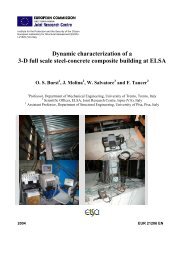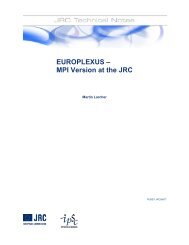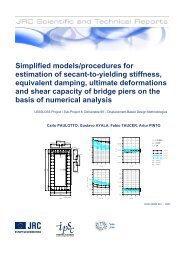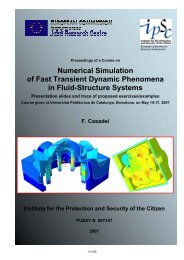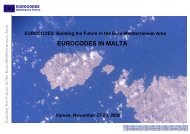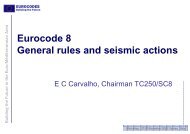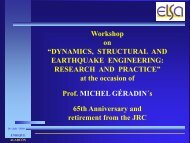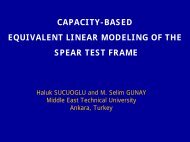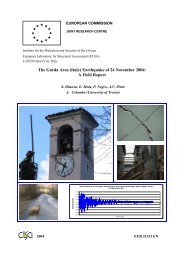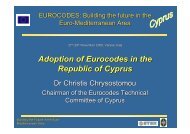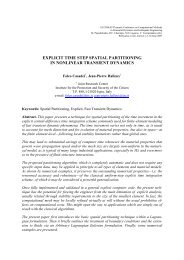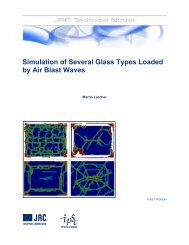Simulation of the Effects of an Air Blast Wave - ELSA - Europa
Simulation of the Effects of an Air Blast Wave - ELSA - Europa
Simulation of the Effects of an Air Blast Wave - ELSA - Europa
- No tags were found...
Create successful ePaper yourself
Turn your PDF publications into a flip-book with our unique Google optimized e-Paper software.
7 Implementation <strong>of</strong> <strong>an</strong> <strong>Air</strong> <strong>Blast</strong> Loading Function7.1 MotivationCalculations using <strong>the</strong> explosive with <strong>the</strong> JWL-equation may produce accurate results but need alsosmall elements. This results in small time step sizes <strong>an</strong>d large computation times. There are severalpossibilities to reduce this cost, as shown in chapter 3. One <strong>of</strong> <strong>the</strong>se is <strong>the</strong> use <strong>of</strong> a load-timefunction instead <strong>the</strong> fluid-structure interaction.This load-time function c<strong>an</strong> be used if reflections <strong>of</strong> <strong>the</strong> air blast wave do not have <strong>an</strong> influence <strong>an</strong>dif <strong>the</strong>re is no need to consider <strong>the</strong> shadowing <strong>of</strong> <strong>the</strong> structure. The load-time function depends on<strong>the</strong> size <strong>of</strong> <strong>the</strong> charge, <strong>the</strong> dist<strong>an</strong>ce from <strong>the</strong> charge <strong>an</strong>d some o<strong>the</strong>r conditions. The adv<strong>an</strong>tage <strong>of</strong>this method is <strong>the</strong> reduction <strong>of</strong> <strong>the</strong> computation time.Calculations with this method c<strong>an</strong> be used to get <strong>an</strong> idea <strong>of</strong> <strong>the</strong> behaviour <strong>of</strong> <strong>the</strong> structure <strong>an</strong>d to validateresults <strong>of</strong> a fluid-structure-interaction for special cases.7.2 Used FunctionThe modified Friedl<strong>an</strong>der equation from Baker [2] (see equation(4)) c<strong>an</strong> be used for <strong>the</strong> implementation.The parameters <strong>of</strong> this equation c<strong>an</strong> be chosen from Kingery [14] or from Baker [2]. Theparameter b for <strong>the</strong> (decay) c<strong>an</strong> be calculated with <strong>the</strong> knowledge <strong>of</strong> <strong>the</strong> maximum negativepressure or with <strong>the</strong> knowledge <strong>of</strong> <strong>the</strong> impulse. The value <strong>of</strong> b, as calculated in chapter 2.2.5, willbe used here.7.3 ImplementationThe load-time function is implemented as a new imped<strong>an</strong>ce. Imped<strong>an</strong>ces enable <strong>the</strong> input <strong>of</strong> boundaryconditions for special elements (CLxx) lying over <strong>the</strong> common elements. The comm<strong>an</strong>d for <strong>the</strong>imped<strong>an</strong>ce air blast wave (IMPE AIRB) allows <strong>the</strong> definition <strong>of</strong> a size <strong>of</strong> <strong>the</strong> charge, <strong>the</strong> origin <strong>of</strong><strong>the</strong> detonation <strong>an</strong>d <strong>the</strong> starting time <strong>of</strong> <strong>the</strong> detonation. Different conditions with different parametersare possible. Spherical <strong>an</strong>d hemispherical explosion c<strong>an</strong> be considered, also with reflectionconditions. The following conditions are possible by choosing <strong>the</strong> CONF parameter:1 = spherical detonation (full space), reflection conditions, equation form Kingery2 = spherical detonation (full space), no reflection conditions, equation form Kingery3 = spherical detonation (full space), no reflection conditions, equation form Baker4 = hemispherical detonation (half space), reflection conditions, equation form Kingery62



